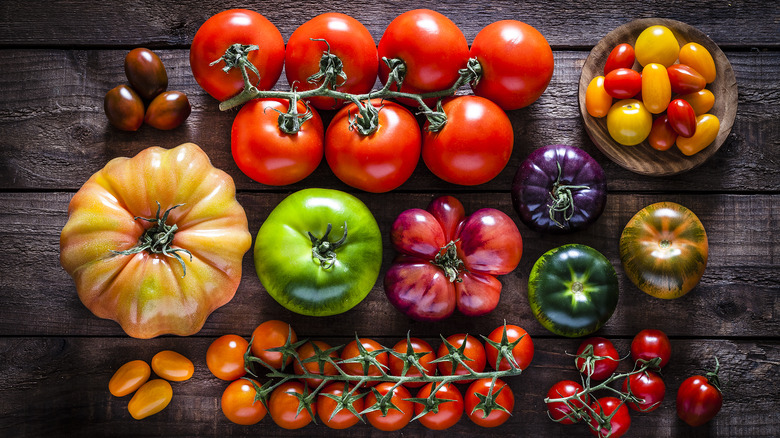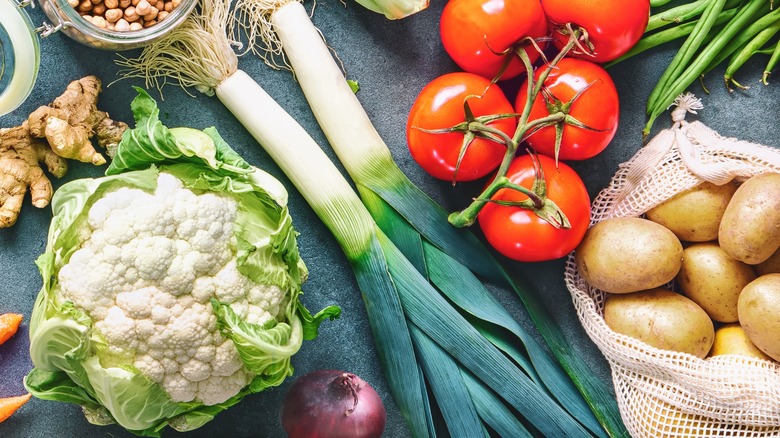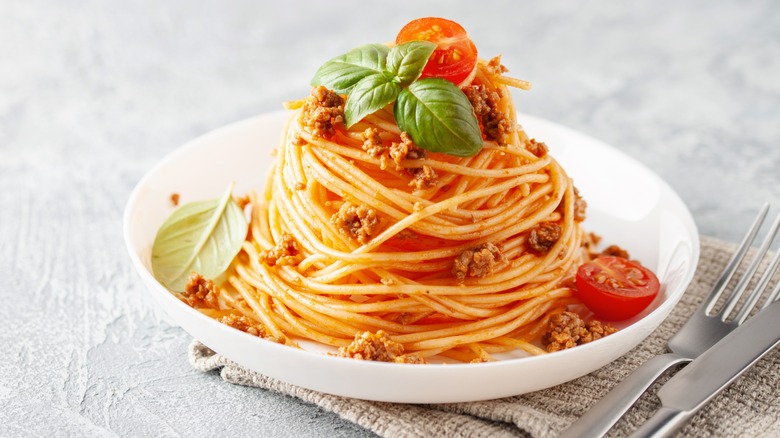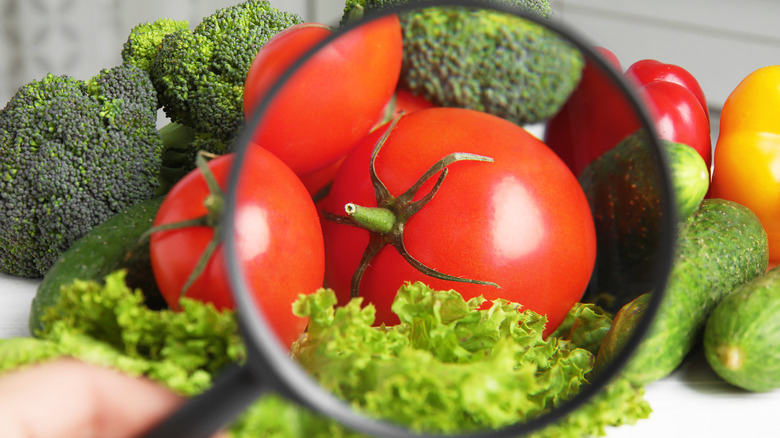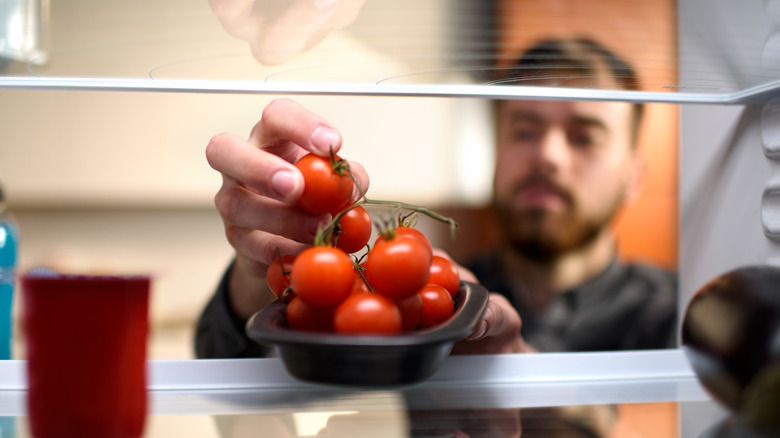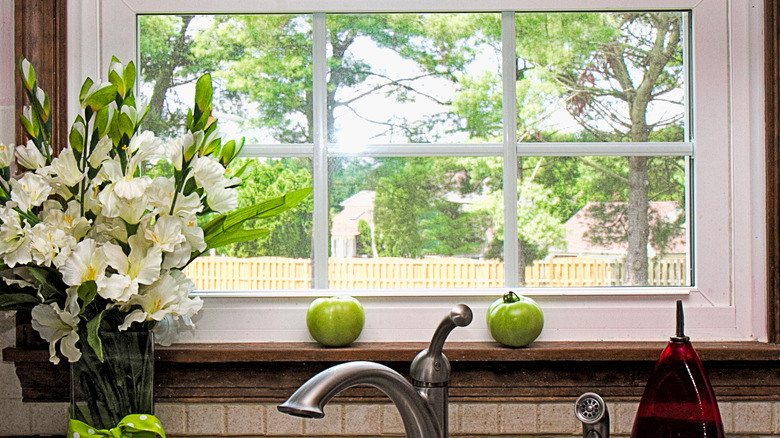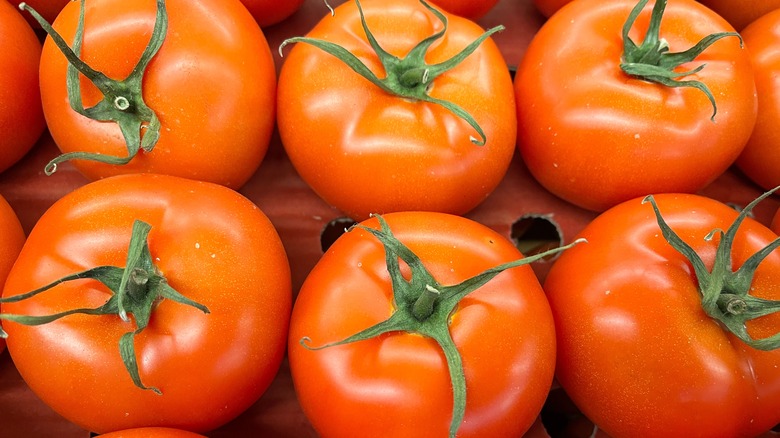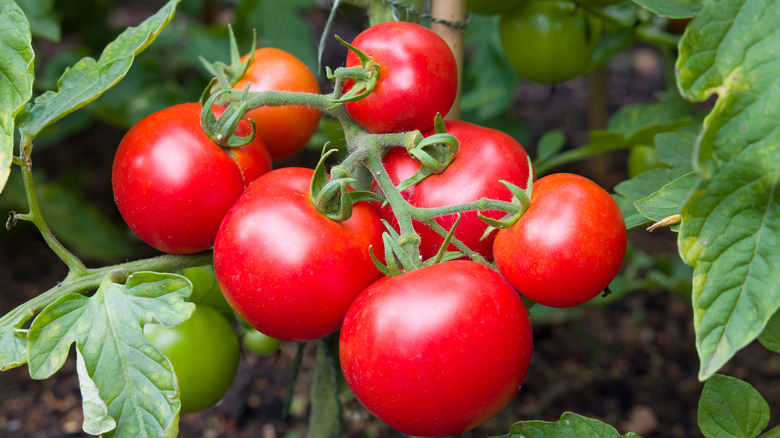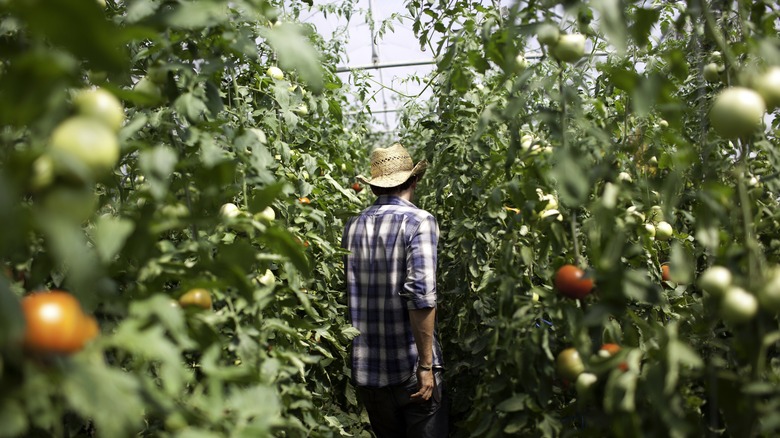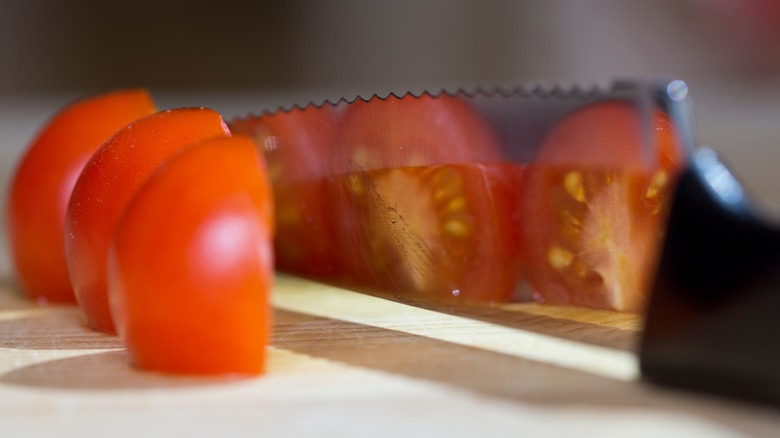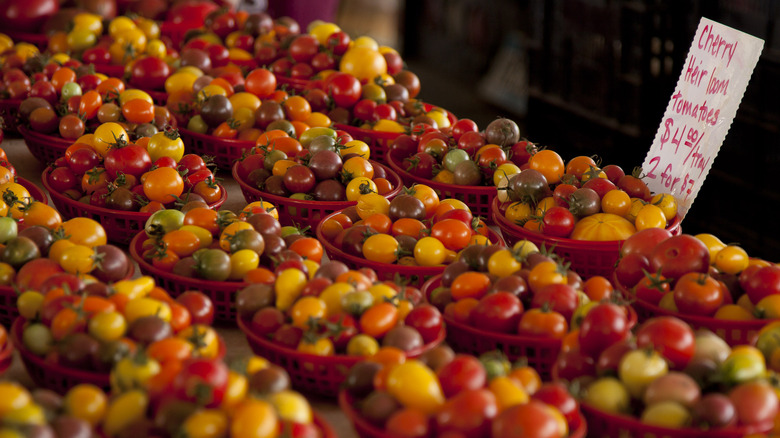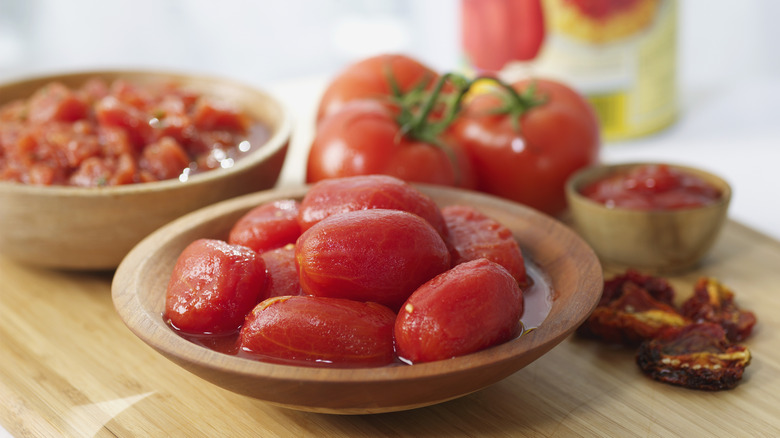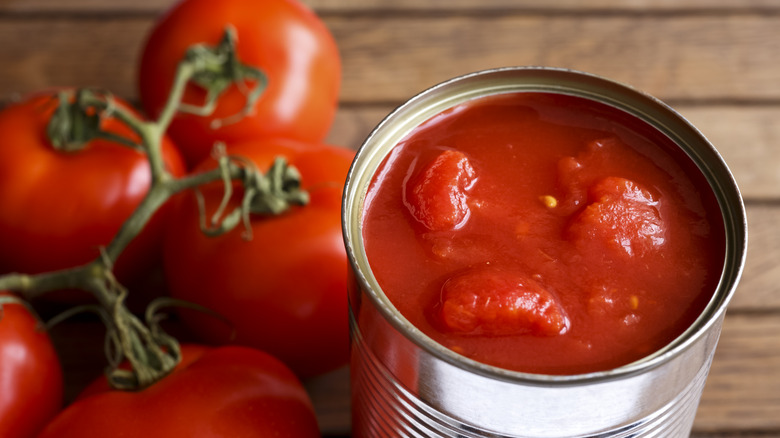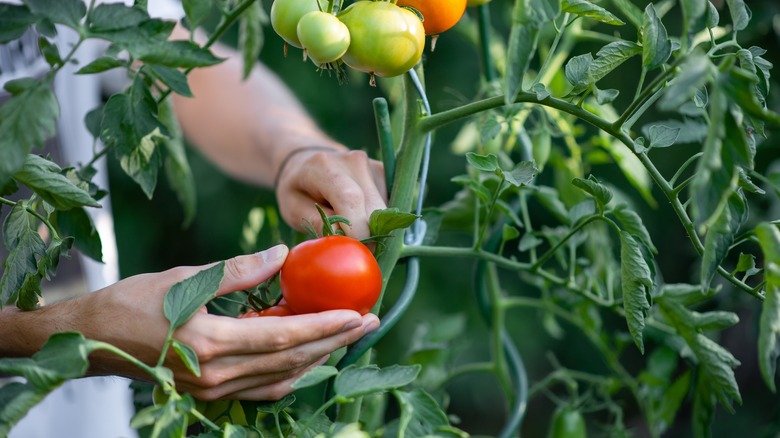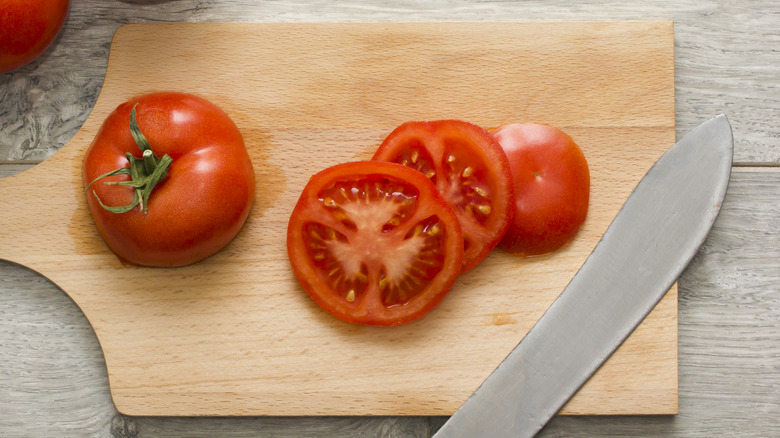16 False Facts About Tomatoes You Thought Were True
Tomatoes have been shrouded in false facts ever since they landed in the Old World. While we no longer think they're poisonous like some Europeans once did, we still hold onto plenty of myths that just aren't true. Tomatoes are quite the misunderstood food. You likely don't know where they originated, exactly how to categorize them, and which parts are safe to eat. You're probably also ripening them, storing them, cooking them, and even slicing them the wrong way. Many people also have some misconceptions about tomato health benefits and side effects.
Before you eat another tomato, we want to help set the record straight for you. We'll help peel away the untruths and arm you with plenty of tomato facts. Next time you eat tomatoes, we promise you'll appreciate them a little more, and even have some new tomato facts and skills at your disposal. You might even be ready to try different parts of tomatoes you've never tried before.
1. Tomatoes are vegetables
If you've embraced the false fact that tomatoes are vegetables, we hate to tell you that you're wrong — botanically speaking. So, what makes a tomato a fruit rather than a veggie? The fruit of a plant is essentially its ovaries and contains the seeds that the plant uses to reproduce itself. If insects fertilize the tomato flower, the seeds will eventually drop out of the ovary (the fruit) and become baby plants. So, technically, a tomato is a fruit since it's full of seeds waiting to be fertilized and drop to the ground to make new tomato plants.
However, since we often use tomatoes like vegetables for savory dishes instead of desserts, it's technically not wrong to call them vegetables in a culinary sense. However, tomatoes are fruits when you get down to the scientific definition. At the end of the day, you could call tomatoes vegetables culinarily speaking, even though they're fruits in the scientific way.
2. Italy has always used tomatoes in its cuisine
When most of us think about Italian cuisine, we think about pasta and pizza that feature tomatoes and tomato sauce. However, tomatoes have only been available in Europe since Spanish explorers brought them back from the New World. Like potatoes, tomatoes are native to Peru.
There are two theories about who brought tomatoes from Spain to Italy. One theory is that they came via Sephardic Jews who fled to Italy in 1492, while another theory has them entering Italy with Eleanor of Toledo when she married Cosimo I de' Medici in 1539. The first written mention of tomatoes in Italy comes from Pietro Andrea Mattioli's 1544 herbal guide. Since the tomatoes he saw were yellow, Mattioli called them "golden apples" or "pomo d'oro." The word eventually morphed into the word "pomodoro," which is what we call slow-simmered tomato sauces today. However, Mattioli suggested cooking them like eggplants instead of turning them into a sauce. Another Italian botanist, Costanzo Felici, wrote about 30 years later that they were best pan-fried and topped with vinegar. Tomato sauce didn't show up in recipes until chef Antonio Latini's 1694 book "The Modern Steward."
3. We've always thought tomatoes were safe to eat
At one point, many Europeans thought tomatoes were poisonous. Enough people died eating tomatoes that they earned the nickname "poison apple." However, it wasn't tomatoes that were poison; the poison came from their serving dishes. If you served tomatoes on a pewter platter, the acidic tomato juices would pull lead into the tomato from the pewter dish. So, while the tomato did start as a non-toxic plant, it ended up becoming poisonous.
A lot of people also thought tomatoes were toxic because they were in the nightshade family. Solanine in nightshades can indeed cause side effects like stomach distress, neurological problems, and even death if you consume too much of it (via ScienceDirect). Plants use solanine to protect themselves from predators, but the nightshades we eat like potatoes and eggplants have been bred over time to have less solanine. Luckily, tomatoes only have solanine in the leaves and vines rather than in the fruit. So, there's no need to limit tomato consumption as long as you're not eating them from lead-infused dishes.
4. You should store tomatoes in the refrigerator
Most of us are guilty of buying fruits and vegetables from the grocery store and indiscriminately placing them in the fridge, thinking that they'll last longer that way. However, not all fruits and vegetables fare better in the fridge. Raw tomatoes are among the foods that are best left out of the fridge. You should take your cue from where grocers place them in the store as to where to store them in your home.
So, why shouldn't you store tomatoes in the fridge? When tomatoes experience cooler temperatures, an enzyme starts to degrade their cell membranes. Rather than experiencing your tomatoes at peak juiciness, you may end up with tomatoes that are more on the mushy side. Additionally, tomatoes can absorb the smells and flavors floating around your fridge, making them taste even less like themselves. Not only will room-temperature tomatoes have a better texture, but they will taste sweeter. If you've refrigerated overripe tomatoes to make them last longer, we suggest getting them to room temperature before eating for optimum flavor.
5. The best way to ripen a green tomato is on the window sill
We often assume that putting a green tomato on the window sill or near a sunny window is the best choice to ripen it since tomatoes grow in the sun. While tomatoes will ripen in a sunny spot, it's not the best option because prolonged sunshine exposure gives it tougher skin, whether on the vine or your windowsill.
Two things can help a green tomato ripen faster: warmth and ethylene gas. The ideal ripening temperature for them is 64 to 77 degrees Fahrenheit. So, don't put them in the fridge if you want them to get riper. Instead, we suggest putting them in a box, bag, or other container along with an ethylene-gas-producing fruit like a banana or apple for a week or two. It's best to ensure that the tomatoes and fruits don't touch each other and that the container isn't trapping too much moisture inside, which could cause the fruits to rot. If they're almost ripe, you could just store them in your fruit bowl near other fruit for a last-minute ripening boost.
6. Tomatoes ripen best right side up
We know this advice is counterintuitive to your normal sense of food orientation, but tomatoes don't ripen best with their stem side up. They actually ripen from the bottom upwards rather than the stem downwards. When you turn them upside down and let them rest on the stem side, the tomato's weight also distributes in a way that helps the tomato stay in good shape while it ripens. However, once the tomato is ripe, you'll want to turn it stem-side up again. Then, store it away from sunlight until you're ready to eat them.
Some people go as far as to cut the tomatoes off the plant with the vine attached and hang the vine upside down to ripen. If you decide to do this, remember to hang them somewhere like the pantry where sunlight won't hit them and toughen up their skins. With this method, you'll want to keep a close watch on them because they'll fall off the vine if you let them get too ripe, and they'll end up on the floor squashed by unsuspecting feet.
7. You can only grow tomatoes in the summer
While it's true that most tomato varieties grow and produce in summer, it's possible to grow them year-round. Growing fresh tomatoes in seasons other than summer depends on the variety you use, your growing zone, and your gardening strategies.
To get tomatoes in the fall or winter, you'll want to plant them 60 to 85 days before the day your area normally has its first frost. However, this will only work if the tomatoes can be pollinated, and if you live in a growing zone where temperatures stay under 95 during the day and under 75 degrees Fahrenheit at night. Another way to get tomatoes past summer is to grow them in a container and move them indoors or into a greenhouse once the weather cools off in fall or winter. Alternatively, you can plant hybrid tomatoes that grow well in colder temperatures. Some cold-loving varieties include Legend, Oregon Spring, Prairie Fire, Glacier, and Siberian.
To get early tomatoes in the spring, you can keep them protected under plastic or products that warm the plant and soil until the temperature increases. Hormone spray will help them produce fruit earlier. If you don't want to bother with those methods, you can simply choose varieties that produce fruit earlier, like the Early Girl varieties, Celebrity, Husky Cherry Red, and Juliet.
8. Fast food restaurants have always sourced their tomatoes from greenhouses
You probably thought all fast food restaurants have always gotten tomatoes in mass quantities from hothouses. However, it was only in early 2019 that Wendy's switched to using all greenhouse-grown tomatoes. Before the transition, it was getting 75% of its tomatoes from non-greenhouse sources in Florida, California, and Mexico that could grow tomatoes when the rest of the U.S. could not.
The idea was to transition to tomatoes that could vine-ripen in greenhouses rather than ones that came green and needed to sit around ripening before Wendy's could use them. Being able to control the flavor of the tomatoes ensures that every restaurant gets tomatoes with the same quality level. Another benefit of using greenhouse-grown tomatoes is that the growing process conserves more water and requires fewer pesticides, making the tomatoes a healthier and more sustainable choice. Fewer pesticides also make for a safer work environment for growers.
9. It doesn't matter which type of knife you use to cut tomatoes
You may not have realized it before, but there's a right way to cut a tomato. If you try cutting tomatoes with the wrong knife type, you'll have a harder time doing it than you should. The skin is deceptively tougher than you'd think, so a serrated knife works better than knives without serrated blades. If you don't have a knife with a serrated blade, you can use an extremely sharp knife that can cut through tough skin like butter.
If you try slicing through a tomato with a dull knife, you'll often need to apply so much pressure that you end up crushing the fruit before it cuts through the surface. Serrated bread knives work perfectly for slicing tomatoes because they pass through the skin while keeping the soft insides intact, much like they pass through a tough bread crust without smashing the soft interior.
10. You have to cut cherry tomatoes one at a time
Cutting cherry tomatoes one at a time is a tedious task, especially if you need to cut more than two or three of them. The uncut ones tend to roll around on your cutting board, eluding your knife. Plus, cutting them one at a time can be time-consuming. We're all for kitchen shortcuts, and the shortcut for cutting cherry or grape tomatoes quickly is an easy one.
To cut more than one cherry tomato at a time, place them on a plate, saucer, or lid. Then place an inverted plate, saucer, or lid of the same size on top of them. While pressing down on the top to keep the tomatoes from rolling around, you'll use a serrated or extra-sharp knife to swipe through the middle of the stacked plates. As your knife passes through, it should cut through the middle of the tomatoes, making quick work of what could have been a tedious task.
11. You should always peel tomatoes before cooking them
If you've been tediously peeling tomatoes by hand or burning your fingers on blanched tomatoes, you can stop now. Granted, some smooth sauces deserve peeled tomatoes, and you'll want to peel tomatoes before canning or freezing them. However, there are plenty of instances where you don't need to peel your tomatoes. For example, there's no reason to peel them for salsas or fresh tomato sauces. There's also no reason to peel tomatoes before chopping them up for pizza toppings or salads. In some cases like roasting tomatoes or adding them to sandwiches, the skin keeps the tomato intact so that it doesn't turn into mush.
One good reason to keep the skin on your tomato is that the antioxidant-rich flavonoids and lycopene in tomatoes are mainly in their skin (via Healthline). The skin is also a good source of other antioxidants like phenolic acids and ascorbic acids. Tomato skin also contains a variety of minerals the body needs, like calcium, copper, manganese, selenium, and zinc (via ScienceDirect). So, removing the skins takes away some of the tomatoes' health benefits.
12. You can cook tomatoes in any pan
Tomatoes are extremely acidic, so you have to consider how the acid will react with the metal of the pan. If you cook tomatoes in a non-anodized aluminum pan, it will ruin both your pan and your food. The acid will pull aluminum out of the pan, which can end up causing your food to taste like metal and leave pits in the pan. The good news is that the Agency for Toxic Substances and Disease Registry says that, if you consume aluminum, your body will only absorb 0.01 to 5% of it. Luckily, a study from Deutsches Ärzteblatt International shows that most people with aluminum loads high enough to induce negative neurological results usually work with aluminum on the job.
Many people avoid cooking tomatoes in a cast iron pan for flavor's sake. However, you're not likely to detect a metallic flavor in your dish unless you cook tomatoes in iron for 30 minutes or longer. For best results, remove the tomatoes after cooking.
13. Canned tomatoes are as healthy as fresh tomatoes
While canned tomatoes are convenient, they're not necessarily as healthy as using fresh tomatoes. A study from the Food Science Nutrition journal shows that the process of heat-treating tomatoes inside the can create dimethyl sulfide, which can eventually work its way through to the lining and into the metal. If it reaches the metal, it begins to corrode it, and allows tin and iron to mix in with the tomatoes, which will make the tomatoes taste metallic. The CDC says ingesting large amounts of tin can cause stomach, liver, and kidney problems. Plus, it can also cause anemia. While it says that our gastrointestinal system doesn't absorb tin well, the CDC still suggests limiting the number of canned products you consume (such as canned tomatoes).
Something else to consider is that most canned tomatoes come without skins, which is where a lot of the nutrients reside. So, if you're wanting to get the most nutrition possible from tomatoes, it's best to start with fresh ones with peels rather than skinless canned tomatoes.
14. Tomato stems and leaves are too poisonous to eat
Most of us have always assumed that tomato stems and leaves are poisonous. After all, they're in the nightshade family, and have a strong smell that can be offensive to some potential predators of the plant. High doses of a compound found in tomato plants called solanine could potentially make you nauseous at the very least, or cause hallucinations or death as extremes. However, food scientist Harold McGee reveals in a New York Times article that there's not a lot of medical evidence showing people or animals reaching medical extremes eating tomato stems and leaves. McGee cites "Toxic Plants of North America" as saying you'd need to engage in the unlikely act of eating a whole pound of tomato leaves to start experiencing any toxic side effects.
There aren't a whole lot of recipes out there for tomato leaves. However, people sometimes add them to tomato sauce to give it a fresher flavor. You can also use tomato leaves to infuse olive oil, add them as a dried herb for stews, use them to make tea, or even turn them into pesto.
15. Tomato seeds are neither good nor bad for you
Most of us haven't considered whether tomato seeds are good or bad for us. For the most part, we just ignore them. It turns out that they're good for you with multiple applications. At the very least, the seeds contain a lot of fiber, which is part of a healthy diet. A paper in the Biology scientific journal explains that the seeds also contain lycoperosides. These saponins have a steroidal-type effect that seems to help to relieve inflammation.
Other applications for tomato seeds include turning them into tomato seed oil. You'll find tomato seed oil in anti-aging products and sunscreens since they contain antioxidants and help protect against UV rays. Doctors once told patients suffering from diverticulitis to avoid nuts and seeds like tomato seeds. However, UCSF's Department of Surgery says that more recent studies indicate that it's fine to eat tomato seeds without worrying that they'll cause a flare-up of the disease.
16. Tomatoes cause inflammation
Another false fact about tomatoes is that they cause inflammation and cause stomach issues. There's a myth that nightshades like eggplants and tomatoes contribute to inflammation because of their solanine content. However, UCLA Health says that there aren't any studies indicating that nightshades are the actual cause of inflammation. Some people still worry that tomatoes may make current inflammation worse even if they're not the root cause. However, Houston Methodist says that there's no scientific research to back up the idea of nightshades worsening pre-existing inflammation either.
As we've already mentioned, there's a chance that tomato seeds may actually help relieve inflammation. So, not only is there no indication that tomatoes cause inflammation, but they may actually be good for your inflammation. With scientists thus far not having found any reasons to avoid nightshades like tomatoes, if you're worried about inflammation, you might as well enjoy these delicious fruits.
